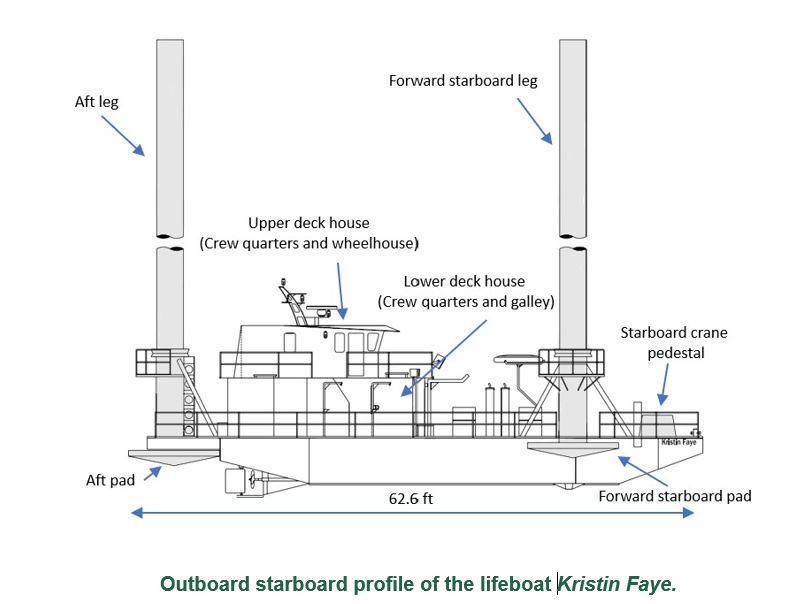Safety Flash: Overturning of the Lifeboat Kristin Faye
4 min readThe National Transportation Safety Board (NTSB) of the United States has published Marine Accident Brief MAB 20-36 relating to the overturning of lifeboat (small jack-up) Kristin Faye. Liftboats are three- or four-legged, self-propelled, self-elevating vessels typically servicing Gulf of Mexico offshore facilities (such as oil drilling platforms) by providing cranes and deck space.
What happened
On September 8, 2019, about 1015 local time, the lifeboat Kristin Faye overturned while preparing to conduct work alongside a platform in the Gulf of Mexico, about 18 miles east of Venice, Louisiana. All three crewmembers abandoned the vessel and were rescued. One person suffered minor injuries during the evacuation. An estimated 120 gallons of diesel fuel were released. The vessel was declared a constructive total loss at an estimated US$750,000.

Background
Liftboats are three- or four-legged, self-propelled, self-elevating vessels. They typically service offshore facilities (such as oil drilling platforms) by providing cranes and deck space. They carry cargo and personnel offshore and, once on location, elevate or “jack up” out of the water to allow crews to carry out work. The lifeboat Kristin Faye was outfitted with three 105-foot-long hydraulically-driven legs that allowed the vessel to lift out of the water once the 7-foot-by-20-foot pads of the legs were in place on the seafloor. The Kristin Faye was crewed by three: a captain, a deckhand, and a cook. The vessel was fitted with two extending/telescoping boom cranes on its bow: one crane mounted on a pedestal to starboard and a larger-capacity crane to port. Kristin Faye was working in the Main Pass lease area of the Gulf of Mexico, servicing various platforms for 37 days prior to the accident. Operations included the September 3 removal and transfer of a 17,000-pound tank from the offshore Platform AQ to a supply boat, which brought it ashore for repair. Prior to this operation, on September 2, a third-party contractor hired by Sanare Energy Partners, LLC, the owner of Platform AQ, conducted a bottom survey in the vicinity of Platform AQ to ensure the ocean floor was clear of pipelines, any existing “can holes” (impressions left in the seabed by previous jack-ups), bottom impressions left by another vessel, or any other hazards to a lifeboat setting down its legs in the area. A bottom survey consists of a sonar reading of the seafloor bottom and is sometimes conducted prior to lifeboat operations taking place. Five days before the accident, tin Faye began working at another platform in the Main Pass 64
Overturning of the Lifeboat Kristin Faye
NTSB/MAB-20/36 fields, remaining in a jacked-up position for approximately 4 to 5 days without incident, before returning to Platform AQ.


What was the cause
The probable cause determined by the NTSB was the company’s inadequate preload procedure that did not account for crane movements or the planned loads (weights) to be lifted, resulting in a “punch-through” of one of the vessel’s three legs.
These flashes summarise key safety matters and incidents, allowing wider dissemination of lessons learned from them. The information below has been provided in good faith by members and should be reviewed individually by recipients, who will determine its relevance to their own operations. The effectiveness of the safety flash system depends on receiving reports from members in order to pass on the information and avoid repeat incidents.
Source and download the full report from here
| Alert ID: | 06/DCA19FM050 |
| Published: | January 05 2021 |
| Download: | Full Report (600 kB) |
Read More Safety Flash
- Safety Flash: Mobile concrete placing boom overturn incidents
- Safety Flash: Not Following Work permit and Isolation Procedure
- Safety Flash: Floorman arm pinned by Pipe Handling Equipment
- Safety Flash: Suspension Trauma
- Safety Flash: Fatality: explosive failure of corroded fire extinguisher
- Safety Flash: Crewman fell to his death through faulty grating
- Safety Flash: Fatal accident during cargo operations on Karina C
- Safety Flash: Overturning of the Lifeboat Kristin Faye
- Safety Flash: Short circuit on 440v AC bus bars-arc flash
- Safety Flash: Towing Fatality
- Safety Flash: Unsafe lifting operations
- Safety Flash: Electric Shock Resulting in Burn
- Safety Flash: LTI- Loss of Finger Tip and Nail
- Safety Flash: Explosion And Fire Onboard The chemical Tanker STOLT Greenland
- Safety Flash: Finger injury caused by incorrectly secured console cover
- Safety Flash: double Man overboard Resulting in one fatality
- Safety Flash: Alcohol-based hand sanitizer warning
- Safety Flash: Dump truck operator fatally electrocuted by high-voltage line
- Safety Flash: Laborer Dies After Footing Collapse – North Carolina
- Safety Flash: Reducing the risk of propane explosions in food trucks
- Safety Flash: Teen Roofer Electrocuted when Ladder Contacts High Voltage Power Line
- Safety Flash: Worker dies from carbon monoxide poisoning while using pressure washer
- Safety Flash: Explosion during welding operation
- A Bathtub Refinisher Dies from Methylene Chloride Exposure :Safety Flash
- Landscaper dies after auger entanglement:Safety Flash
- Worker dies after falling from scaffold
- Fatality Investigation: Orchard Worker Dies After Falling Off Tractor
- LTI: Fall from height leading to Multiple Fractures
- Operator dies when forklift falls off loading dock
- Worker struck, killed by outrigger
- Worker killed by platform
- Scaffolding Components
- Construction Worker Killed When Pipe Rolls Off a Trailer
- Protecting workers from falls
- Near-Miss: Shackle Configuration
- Improper use of lifeline results in death of worker



